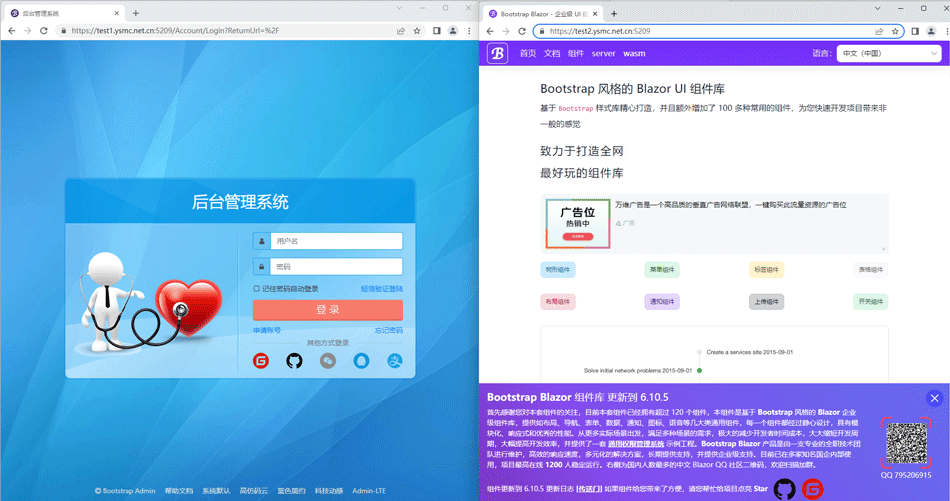.NET使用YARP通过编码方式配置域名转发实现反向代理
浏览:8日期:2023-05-10 09:57:48
前面介绍了 YARP 通过配置文件的方式配置代理转发(传送门),而众所周知,微软的一贯作风就是能通过配置文件做的事情,通过编码的方式也能实现!YARP 也不例外,废话不多说,直接上代码!
首先,参照官方文档,我们先新建一个 InMemoryConfigProvider 类,并且继承 IProxyConfigProvider 接口,类里面还包含了一个 IProxyConfig 的类,别看漏了噢!
这里多嘴一下,下面的代码出现了 volatile 关键字,介绍一下它:volatile 是 C# 中用于控制同步的关键字,其意义是针对程序中一些敏感数据,不允许多线程同时访问,保证数据在任何访问时刻,最多有一个线程访问,以保证数据的完整性,volatile 是修饰变量的修饰符。
public class InMemoryConfigProvider : IProxyConfigProvider
{
private volatile InMemoryConfig _config;
public InMemoryConfigProvider(IReadOnlyList<RouteConfig> routes, IReadOnlyList<ClusterConfig> clusters)
{
_config = new InMemoryConfig(routes, clusters);
}
public IProxyConfig GetConfig() => _config;
public void Update(IReadOnlyList<RouteConfig> routes, IReadOnlyList<ClusterConfig> clusters)
{
var oldConfig = _config;
_config = new InMemoryConfig(routes, clusters);
oldConfig.SignalChange();
}
private class InMemoryConfig : IProxyConfig
{
private readonly CancellationTokenSource _cts = new();
public InMemoryConfig(IReadOnlyList<RouteConfig> routes, IReadOnlyList<ClusterConfig> clusters)
{
Routes = routes;
Clusters = clusters;
ChangeToken = new CancellationChangeToken(_cts.Token);
}
public IReadOnlyList<RouteConfig> Routes { get; }
public IReadOnlyList<ClusterConfig> Clusters { get; }
public IChangeToken ChangeToken { get; }
internal void SignalChange()
{
_cts.Cancel();
}
}
}
然后添加一个扩展 InMemoryConfigProviderExtensions
public static class InMemoryConfigProviderExtensions
{
public static IReverseProxyBuilder LoadFromMemory(this IReverseProxyBuilder builder, IReadOnlyList<RouteConfig> routes, IReadOnlyList<ClusterConfig> clusters)
{
builder.Services.AddSingleton<IProxyConfigProvider>(new InMemoryConfigProvider(routes, clusters));
return builder;
}
}
接下来就是写配置了,我个人还是喜欢在配置文件中写,但是有动态配置需求的话,又不想登录服务器编辑 appsetting 文件,通过编码的方式确实更为方便,将配置写进库或者其它存储方式里面,那将是随心所欲啊!上代码:
Program.cs
var routes = new[]
{
new RouteConfig()
{
RouteId = "admin",
ClusterId = "admin",
Match = new RouteMatch
{
Hosts = new string[] {"test1.ysmc.net.cn" },
Path = "{**catch-all}"
}
},
new RouteConfig()
{
RouteId = "blazor",
ClusterId = "blazor",
Match = new RouteMatch
{
Hosts = new string[] {"test2.ysmc.net.cn" },
Path = "{**catch-all}"
}
}
};
var clusters = new[]
{
new ClusterConfig()
{
ClusterId = "admin",
LoadBalancingPolicy = "RoundRobin",
Destinations = new Dictionary<string, DestinationConfig>(StringComparer.OrdinalIgnoreCase)
{
{ "admin", new DestinationConfig() { Address = "https://admin.blazor.zone" } }
}
},
new ClusterConfig()
{
ClusterId = "blazor",
LoadBalancingPolicy = "RoundRobin",
Destinations = new Dictionary<string, DestinationConfig>(StringComparer.OrdinalIgnoreCase)
{
{ "blazor", new DestinationConfig() { Address = "https://www.blazor.zone" } }
}
}
};
builder.Services.AddReverseProxy().LoadFromMemory(routes, clusters);
上面的配置代码,跟配置文件方式的节点和属性,都是对应的,照着写就是了
"ReverseProxy": {
"Routes": {
"admin": {
"ClusterId": "admin",
"Match": {
"Hosts": [ "test1.ysmc.net.cn" ],
"Path": "{**catch-all}"
}
},
"blazor": {
"ClusterId": "blazor",
"Match": {
"Hosts": [ "test2.ysmc.net.cn" ],
"Path": "{**catch-all}"
}
}
},
"Clusters": {
"admin": {
"LoadBalancingPolicy": "RoundRobin",
"Destinations": {
"admin": {
"Address": "https://admin.blazor.zone/"
}
}
},
"blazor": {
"LoadBalancingPolicy": "RoundRobin",
"Destinations": {
"blazor": {
"Address": "https://www.blazor.zone/"
}
}
}
}
}
最终效果还是依旧的完美,感谢大佬的观看,谢谢!

以上就是这篇文章的全部内容了,希望本文的内容对大家的学习或者工作具有一定的参考学习价值,谢谢大家对的支持。如果你想了解更多相关内容请查看下面相关链接
标签:
ASP.NET
相关文章:
1. 使用EF Code First搭建简易ASP.NET MVC网站并允许数据库迁移2. ASP.NET MVC解决上传图片脏数据的方法3. asp.net生成HTML4. asp.net core 认证和授权实例详解5. ASP.NET MVC实现区域或城市选择6. .NET使用StackTrace获取方法调用信息的代码演示7. 在.NET Core 中使用 FluentValidation 进行规则验证的方法8. ASP.Net 自定义转换器JsonConverter的使用详解9. ASP.Net MVC利用NPOI导入导出Excel的示例代码10. .NET Core 分布式任务调度ScheduleMaster详解
- 排行榜

- HTTP_HOST 和 SERVER_NAME 的区别
- 1. PHP基础知识详细讲解
- 2. Laravel中数据库迁移操作的示例详解
- 3. Golang 正则匹配效率详解
- 4. IE浏览器不支持getElementsByClassName是什么原因?解决方法分享
- 5. ASP.NET堆和栈三之引用类型对象拷贝和内存分配
- 6. 怎样全系IE支持Bootstrap?解决方法介绍
- 7. JS中的常见数组遍历案例详解(forEach, map, filter, sort, reduce, every)
- 8. 一个模仿oso的论坛程序(之二)
- 9. Zend Studio5.5测试版 兼容三系统
- 10. 做个自己站内搜索引擎
 网公网安备
网公网安备